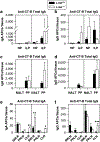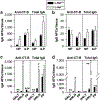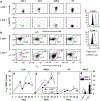Distal IgA immunity can be sustained by alphaEbeta7+ B cells in L-selectin-/- mice following oral immunization
- PMID: 19079162
- PMCID: PMC9811399
- DOI: 10.1038/mi.2007.2
Distal IgA immunity can be sustained by alphaEbeta7+ B cells in L-selectin-/- mice following oral immunization
Abstract
Understanding the role of homing receptors could aid vaccine strategies for developing distal mucosal immunity. Infection studies have revealed that immune intestinal B cells use alpha(4)beta(7) homing receptors, but their role in subsequent oral immunization with soluble antigens is unknown. To assess the influence of L-selectin and alpha(4)beta(7) on distal B cells following oral cholera toxin (CT) immunization, L-selectin-deficient (L-Sel(-/-)) IgA anti-CT-B-specific B cells were enhanced 30-, 9.2-, and 3.5-fold in head and neck lymph nodes (HNLNs), nasal-associated lymphoid tissue, and nasal passages (NPs), respectively, vs. L-Sel(+/+) mice. Cell-sorted intestinal and NP IgA antibody-forming cells (AFCs) were mostly alpha(4)beta(7)(+), unlike HNLN L-Sel(-/-) IgA and IgG anti-CT-B AFCs that were alpha(E)beta(7)(+), contrasting with L-Sel(+/+) HNLN IgA AFCs that were mostly alpha(4)beta(7)(+). In vitro studies revealed that L-Sel(-/-) HNLN B cells preferentially expressed alpha(E) following polyclonal stimulation. These studies show that HNLN B cells express alpha(E)beta(7) in the absence of L-selectin to sustain distal IgA responses.
Conflict of interest statement
DISCLOSURE
The authors declared no conflict of interest.
Figures








Similar articles
-
Absence of L-selectin delays mucosal B cell responses in nonintestinal effector tissues.J Immunol. 2002 Nov 15;169(10):5649-59. doi: 10.4049/jimmunol.169.10.5649. J Immunol. 2002. PMID: 12421944
-
Cutting edge: dichotomy of homing receptor dependence by mucosal effector B cells: alpha(E) versus L-selectin.J Immunol. 2001 Sep 1;167(5):2441-5. doi: 10.4049/jimmunol.167.5.2441. J Immunol. 2001. PMID: 11509580
-
Topographic distribution of homing receptors on B and T cells in human gut-associated lymphoid tissue: relation of L-selectin and integrin alpha 4 beta 7 to naive and memory phenotypes.Am J Pathol. 1997 Jan;150(1):187-99. Am J Pathol. 1997. PMID: 9006335 Free PMC article.
-
Mucosal vaccines based on the use of cholera toxin B subunit as immunogen and antigen carrier.Dev Biol Stand. 1994;82:215-27. Dev Biol Stand. 1994. PMID: 7958476 Review.
-
Strategies for the induction of immune responses at mucosal surfaces making use of cholera toxin B subunit as immunogen, carrier, and adjuvant.Am J Trop Med Hyg. 1994;50(5 Suppl):42-54. Am J Trop Med Hyg. 1994. PMID: 8203723 Review.
Cited by
-
Involvement of L-selectin expression in Burkholderia pseudomallei-infected monocytes invading the brain during murine melioidosis.Virulence. 2017 Aug 18;8(6):751-766. doi: 10.1080/21505594.2016.1232239. Epub 2016 Sep 19. Virulence. 2017. PMID: 27646437 Free PMC article.
-
An integrin αEβ7-dependent mechanism of IgA transcytosis requires direct plasma cell contact with intestinal epithelium.Mucosal Immunol. 2021 Nov;14(6):1347-1357. doi: 10.1038/s41385-021-00439-x. Epub 2021 Aug 20. Mucosal Immunol. 2021. PMID: 34417548 Free PMC article.
-
Nasal vaccination of β7 integrin-deficient mice retains elevated IgA immunity.Immunol Cell Biol. 2020 Sep;98(8):667-681. doi: 10.1111/imcb.12364. Epub 2020 Jul 8. Immunol Cell Biol. 2020. PMID: 32479679 Free PMC article.
-
Rejuvenation of mucosal immunosenescence by adipose tissue-derived mesenchymal stem cells.Int Immunol. 2017 Jan 1;29(1):5-10. doi: 10.1093/intimm/dxx001. Int Immunol. 2017. PMID: 28391291 Free PMC article. Review.
-
Novel vaccine development strategies for inducing mucosal immunity.Expert Rev Vaccines. 2012 Mar;11(3):367-79. doi: 10.1586/erv.11.196. Expert Rev Vaccines. 2012. PMID: 22380827 Free PMC article. Review.
References
-
- Rudzik R, Clancy RL, Perey DY, Day RP & Bienenstock J Repopulation with IgA-containing cells of bronchial and intestinal lamina propria after transfer of homologous Peyer’s patch and bronchial lymphocytes. J. Immunol 114, 1599–1604 (1975). - PubMed
-
- Mestecky J, McGhee JR, Michalek SM, Arnold RR, Crago SS & Babb JL Concept of the local and common mucosal immune response. Adv. Exp. Med. Biol 107, 185–192 (1978). - PubMed
-
- McDermott MR & Bienenstock J Evidence for a common mucosal immunologic system. I. Migration of B immunoblasts into intestinal, respiratory, and genital tissues. J. Immunol 122, 1892–1898 (1979). - PubMed
-
- Quiding-Jarbrink M, Nordstrom L, Granstrom G, Kilander A, Jertbom M, Butcher EC et al. Differential expression of tissue-specific adhesion molecules on human circulating antibody-forming cells after systemic, enteric, and nasal immunizations. A molecular basis for the compartmentalization of effector B cell responses. J. Clin. Invest 99, 1281–1286 (1997). - PMC - PubMed
-
- Kantele A, Hakkinen M, Moldoveanu Z, Lu A, Savilahti E, Alvarez RD et al. Differences in immune responses induced by oral and rectal immunizations with Salmonella typhi Ty21a: evidence for compartmentalization within the common mucosal immune system in humans. Infect. Immun 66, 5630–5635 (1998). - PMC - PubMed
Publication types
MeSH terms
Substances
Grants and funding
LinkOut - more resources
Full Text Sources
Molecular Biology Databases
Miscellaneous

